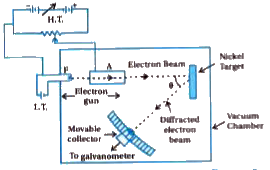
Consider arrangement shown In figure for davisson-Germer experiment when voltage applied to A is increased in diffracted beam will have maximum number of electron for value diffraction angle (θ) such that…..Solution in Gujrati
Will be larger than the earlier value.
Will be the same as the earlier value
Will be less than the earlier value
Will depend on the target
The correct Answer is:C
In the present case ,Path diffrence between matter waves diffracted from the onsecutive atomic layers of targer element,separated by perpendiular distance d is equal to 2dsinθ (where θ=angle of diffraction).
Now ,as per the statement,for no.Of electrons getting diffracted at angle θ to become maximum,value of matter wavelength of moving electrons.λ should be such that it can satisfy the condition of constructive interference.
Thus ,2din θλ
∴ 2din θ=n(h√2Vem)
⇒ As V increases, sinθ decreases and so θ will also decrease.
Second method:
In Dacisson-Germer experiment let voltage applied to andoe is V.De-Broglie wavelength assocaited wth electron,
λ=12.27√VÅ.......(1)
For electron diffracted at angle θ condition for central maximum λ−2dsinθ.......(2)
From equation (1) if V increase then λ will decrease and from equation (2) in λ decrease then θ will also decrease.
(For samll angle of diffraction sinθ≈θ).
Topper's Solved these Questions
- DUAL NATURE OF RADIATION AND MATTERBook:KUMAR PRAKASHANChapter:DUAL NATURE OF RADIATION AND MATTERExercise:Section-C (multiple choice questions(more than one options)
Explore 5 Videos
- DUAL NATURE OF RADIATION AND MATTERBook:KUMAR PRAKASHANChapter:DUAL NATURE OF RADIATION AND MATTERExercise:Section-C (Very short answer type questions)
Explore 11 Videos
- DUAL NATURE OF RADIATION AND MATTERBook:KUMAR PRAKASHANChapter:DUAL NATURE OF RADIATION AND MATTERExercise:Section-B (QUESTIONS)
Explore 7 Videos
- CURRENT ELECTRICITYBook:KUMAR PRAKASHANChapter:CURRENT ELECTRICITYExercise:SECTION [D] MULTIPLE CHOICE QUESTIONS (MCQs) (MCQs ASKED IN BOARD EXAM AND GUJCET)
Explore 23 Videos
- ELECTRIC CHARGES AND FIELDS Book:KUMAR PRAKASHANChapter:ELECTRIC CHARGES AND FIELDS Exercise:SECTION D MCQS ASKED IN COMPETITIVE EXAMES (MCQS AKSED IN BOARD EXAM AND GUJCET)
Explore 14 Videos
Similar Questions
Relativistic corrections become necessary when the expression for the kinetic energy 12mv2,
becomes comparable with mc2,where m is the mass of the particle.At what de-Broglie wavelength will realtivistic corrections become important for an electron?
View SolutionA proton and an α=particle are accelerated using the same potential difference.How are the de-Broglie wavelengths λp and λa related to each other?
View SolutionMonochromatic light frequency 5.0×1014 Hz is produced by a laser.The power emitted is 66 W. How many photons per second,on an average ,are emitted by the source?
View SolutionA wire is bent in the form of circle of radius 2m. Resistance per unit length of wire is 1πΩm. Battery of 6 V is connected between A and B ∠AOB=90∘ . Find the current through the battery.

View SolutionWhen air is replaced by dielectric medium of constant K, the maximum force of attraction between two charges separated by distance d, ..........
View SolutionIn Davisson-Germer experiment, if the angle of diffraction is 52^(@) , the find the glancing angle.
View SolutionConsider the fundamental physics for class XII. Suppose the voltage applied to A is increased. The diffracted beam will have the maximum at a value of θ that
View SolutionIn Davisson-Germer electron diffraction arrangement if suppose the voltage applied to accelerated electrons is increased, the value of the angles at which diffracted beam have the maximum intensity
View SolutionIn Davisson-Germer experiment the relation between the angle of diffraction theta and the grazing angle 0phi is
View SolutionConsider figure. Suppose the voltage applied to A is increased. The diffracted beam will have the maximum at a value of θ that

View SolutionDraw a neat labelled diagram for Davisson and Germer experiment, for diffraction of electron wave.
View SolutionIn Davisson and Germer experiment, a detector with a galvanometer can be rotated on a circular scale. As the detector is rotaed the intensity of electronic beam after diffraction
View SolutionIn Davisson and Germer experiment, a crystal which diffracts a beam of electrons is of
View SolutionIn Davisson and Germer experiment, if the angle of diffraction is 50∘, then tha angle of glancing will be
View SolutionIn Davisson-Germer experiment the relation between Bragg’s angle phi and diffraction angle theta is
View Solution

